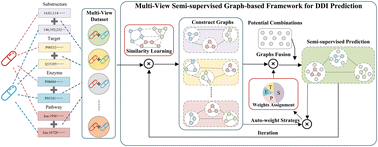A low-cost machine learning framework for predicting drug–drug interactions based on fusion of multiple features and a parameter self-tuning strategy
Abstract
Poly-drug therapy is now recognized as a crucial treatment, and the analysis of drug–drug interactions (DDIs) offers substantial theoretical support and guidance for its implementation. Predicting potential DDIs using intelligent algorithms is an emerging approach in pharmacological research. However, the existing supervised models and deep learning-based techniques still have several limitations. This paper proposes a novel DDI analysis and prediction framework called the Multi-View Semi-supervised Graph-based (MVSG) framework, which provides a comprehensive judgment by integrating multiple DDI features and functions without any time-consuming training process. Unlike conventional approaches, MVSG can search for the most suitable similarity (or distance) measurement among DDI data and construct graph structures for each feature. By employing a parameter self-tuning strategy, MVSG fuses multiple graphs according to the contributions of features' information. The actual anticancer drug data are extracted from the authoritative public database for evaluating the effectiveness of our framework, including 904 drugs, 7730 DDI records and 19 types of drug interactions. Validation results indicate that the prediction is more accurate when multiple features are adopted by our framework. In comparison to conventional machine learning techniques, MVSG can achieve higher performance even with less labeled data and without a training process. Finally, MVSG is employed to narrow down the search for potential valuable combinations.



 Please wait while we load your content...
Please wait while we load your content...